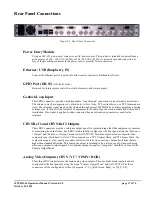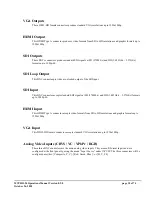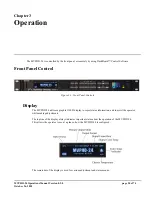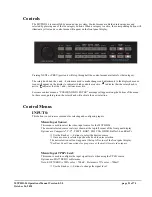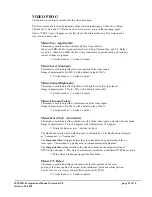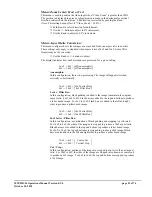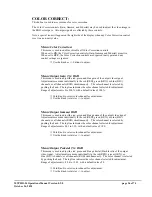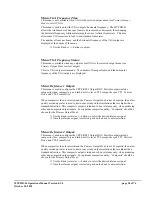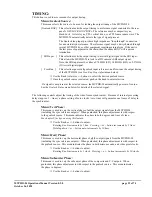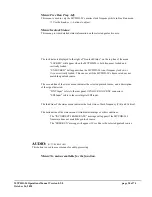
MVPHD-24 Operations Manual Version 0.9.0 page 15 of 74
October 26, 2020
Audio Processing
(FUTURE RELEASE)
The MVPHD-24 contains synchronization and channel multiplexing for embedded audio signals.
SDI Audio Inputs
(FUTURE RELEASE)
The SDI signal provides for sixteen channels of audio (4 embedded groups of 4 channels). When SDI is
selected as the input, these sixteen audio channels are available as audio sources.
HDMI Audio Inputs
(FUTURE RELEASE)
The HDMI signal provides for eight channels of audio (4 stereo pairs). When HDMI is selected as the
input, these eight audio channels are available as audio sources.
Audio Synchronization and Delay
(FUTURE RELEASE)
The selected audio inputs are passed along with video through an audio-video synchronizer. These signals
are then processed by a variable delay buffer. All channels are delayed the same amount as the video
signal, but with an adjustable offset. The audio delay may be offset from video +/- 500ms
Audio Output Mapping
(FUTURE RELEASE)
Full Audio Mapping is possible with the Audio Output Source control. Any input channel may be selected
for any output channel of both SDI and HDMI outputs, including one channel feeding multiple output
channels. In addition to the SDI and HDMI inputs, four internal tone generators and silence are available
as sources.
Audio Levels and Phase
(FUTURE RELEASE)
The mapping function also provides individual level adjustment and phase control for all output channels.
The level of each channel may be adjusted –40 to +20 dB, and the phase of each channel may be inverted
(180 degree phase shift).
Remote Control
Raspberry Pi & Dashboard Control
The MVPHD-24 utilizes a Raspberry Pi for remote control. It has been configured with an openConnect
driver to allow control with Dashboard software when the Ethernet port is connected to a network. The
Raspberry Pi is also connected as an input source, for possible use as a video player. Contact Cal Media
for further information.
Memory Card
The MVPHD-24 has a socket located on the front panel to support SD or MMC memory cards. The
memory card is used for updating the firmware, and for storing or loading still images.
Compatible cards include MMC (multi-media card), SD (secure digital), and SDHC (high capacity). To
support still images, the SD/MMC cards must be formatted with a FAT16 or FAT32 file structure (most
cards greater than 64MB come pre-formatted as either FAT16 or FAT32). The MVPHD-24 conforms to
the FAT32 specification so firmware and still image files may be exchanged easily with most computers.

















